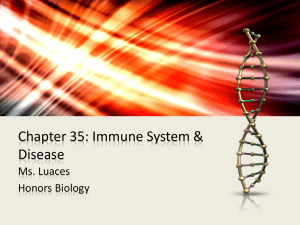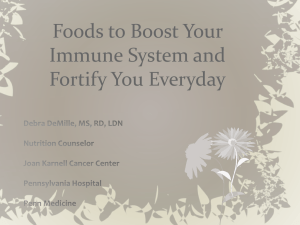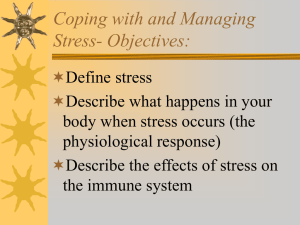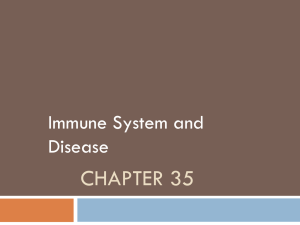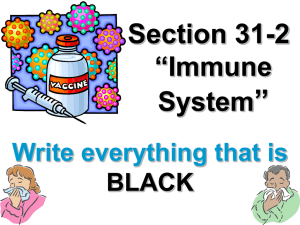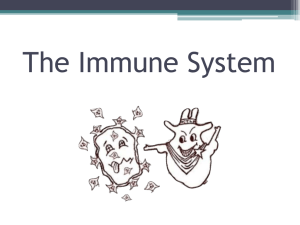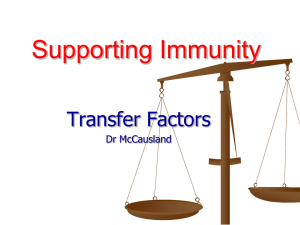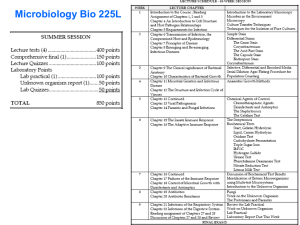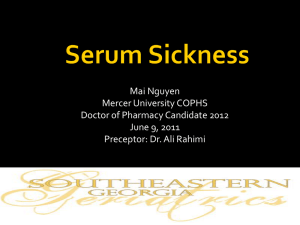File - Biology EOC Review Resources
advertisement
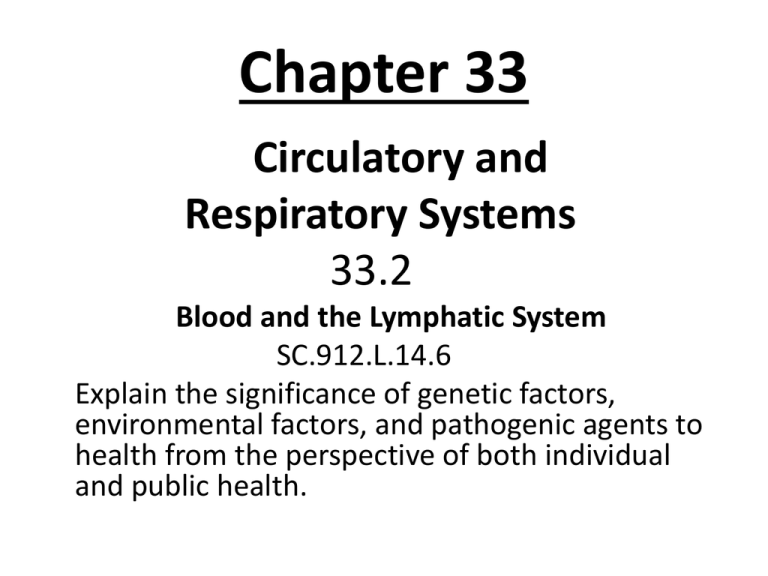
Chapter 33 Circulatory and Respiratory Systems 33.2 Blood and the Lymphatic System SC.912.L.14.6 Explain the significance of genetic factors, environmental factors, and pathogenic agents to health from the perspective of both individual and public health. 33.2 Blood and the Lymphatic System Key Questions • • • • What is the function of each component in blood? What is the function of the lymphatic system? What are three common circulatory diseases? What is the connection between cholesterol and circulatory disease? Vocabulary Pages 954 - 962 33.2 Blood and the Lymphatic System What is the function of each component in blood? is about 90% water and 10% dissolved gases, salts, nutrients, enzymes, hormones, waste products, plasma proteins, cholesterol, and other important compounds. About 55% of the total blood volume is plasma. Water in plasma helps control body temperature Plasma proteins consist of three types: albumin, globulins, and fibrogen (erythocytes) are the most numerous cells in blood. The main function of red blood cells is to transport oxygen. They get their “crimson” color from , a protein that binds oxygen in the lungs and releases it in the capillary network throughout the body. Red Blood Cells transport some CO2 to the lungs. Red Blood Cells are produced by cells in red bone marrow. Red Blood Cells circulate for an average of 120 days before they are destroyed in the liver and spleen. 33.2 Blood and the Lymphatic System What is the function of each component in blood? , or leukocytes, guard against infection, fight parasites, and attack bacteria. An increase in white blood cells is a sign that the body is fighting a serious infection. In a healthy individual, white blood cells are outnumbered by red blood cells by almost 1000 to 13. White blood cells are produced from stem cells in bone marrow. White blood cells keep their nuclei and can live for years. are plasma proteins and cell fragments that make it possible for blood to clot. Platelets come in contact with the edges of broken blood vessels and their surface becomes sticky and they cluster around the wound. These platelets release proteins called clotting factors that start a series of reactions; strands of fibrin form a net that prevents blood from leaving the damaged vessel. 33.2 Blood and the Lymphatic System How Blood Clots Form 33.2 Blood and the Lymphatic System The Lymphatic System What is the function of the lymphatic system? The is a network of vessels, nodes, and organs that collects the lymph that leaves capillaries, “screens” it for microorganisms, and returns it to the circulatory system. When lymph vessels are blocked due to injury or disease and lymph accumulates in tissues, swelling called edema will occur. Lymph vessels run along side the intestines and pick up fats and fat-soluble vitamins from the digestive tract and transport these nutrients into the bloodstream. Lymph nodes (small bean-shaped enlargements) are scattered throughout the body. Lymph nodes act as filters, trapping microorganisms, stray cancer cells, and debris. White blood cells inside lymph nodes destroy these substances but if there is a large amount of these trapped microorganisms, the nodes become enlarged. Old or damaged blood flows through the spleen, where microorganisms are cleansed from the blood and old or damaged blood cells are removed. 33.2 Blood and the Lymphatic System Circulatory System Diseases What are three common circulatory diseases? Diseases of the circulatory system can progress for years before they are discovered. The first sign of circulatory problems is often an event that affects the heart or the brain because tissues in these organs begin to die within moments if they lose their oxygen supply. 33.2 Blood and the Lymphatic System Circulatory System Diseases What are three common circulatory diseases? Three common and serious diseases of the circulatory system are heart disease, stroke, and high blood pressure. Damage to the heart muscle (myocardium) from a heart attack or to the brain from a stroke can be fatal or cause permanent injury. Individuals with high blood pressure are at a higher risk for heart disease and stroke. Heart disease is the leading cause of death in the United States. 33.2 Blood and the Lymphatic System Circulatory System Diseases Heart Disease The heart muscle requires a constant supply of oxygen. This oxygen is supplied through two coronary arteries and their smaller branches. The most common type of heart disease occurs when blood flow through the coronary arteries is obstructed. One of the causes of this arterial obstruction is , a condition in which fatty deposits called plaques build up in artery walls and eventually cause the arteries to stiffen. This plaque build-up can bulge into the middle of the vessel and block blood flow to the heart muscle. The heart can be weakened or damaged by oxygen deprivation which leads to heart failure. Symptoms include chest pains, called angina. 33.2 Blood and the Lymphatic System Circulatory System Diseases 33.2 Blood and the Lymphatic System Circulatory System Diseases Heart Disease Blood clots If the cap on a plaque ruptures, a blood clot may form that completely blocks an artery. 33.2 Blood and the Lymphatic System Circulatory System Diseases 33.2 Blood and the Lymphatic System Circulatory System Diseases Heart Attack 33.2 Blood and the Lymphatic System Circulatory System Diseases Stroke 33.2 Blood and the Lymphatic System Circulatory System Diseases Stroke 33.2 Blood and the Lymphatic System Circulatory System Diseases Stroke Risk Factors 33.2 Blood and the Lymphatic System Circulatory System Diseases High Blood Pressure 33.2 Blood and the Lymphatic System Circulatory System Diseases High Blood Pressure 33.2 Blood and the Lymphatic System Circulatory System Diseases 33.2 Blood and the Lymphatic System Understanding Circulatory Diseases What is the connection between cholesterol and circulatory disease? is a lipid that is part of animal cell membranes. It is also used in the synthesis of some hormones, bile, and vitamin D. is transported in the blood primarily by two types of lipoproteins --- low-density lipoprotein (LDL) and high-density lipoprotein (HDL). LDL is the cholesterol carrier that is most likely to cause trouble in the circulatory system because it becomes part of plaque. HDL, often called the good cholesterol, generally transports excess cholesterol from tissues and arteries to the liver for removal from the body. 33.2 Blood and the Lymphatic System Understanding Circulatory Diseases Cholesterol Levels 33.2 Blood and the Lymphatic System Understanding Circulatory Diseases Sources of Humans consume cholesterol in meat, eggs, dairy products, and fried foods, especially those high in saturated or trans fats 33.2 Blood and the Lymphatic System Understanding Circulatory Diseases Research indicates that high cholesterol levels, along with other risk factors, lead to atherosclerosis and higher risk of heart attack. When blood cholesterol levels are high, liver cells take cholesterol from the blood and do not make it. Defective LDL receptors in the liver don’t allow the liver to remove cholesterol from blood. 33.2 Blood and the Lymphatic System Understanding Circulatory Diseases Keeping Your Circulatory System Healthy 33.2 Assessment (pg. 961) 1a. Review List the main function of plasma, red blood cells, white blood cells, and platelets? 1b. Infer Hemophilia is a genetic disorder that results from a defective protein in the clotting pathway. What do you think happens to a person with hemophilia who has a minor cut?? 2a. Review Describe the role of the lymphatic system. 2b. Compare and Contrast How are the functions of veins and lymphatic vessels similar? How are they different? 3a. Review What are the risk factors for the three common diseases of the circulatory system? 3b. Form a Hypothesis Why do you think atherosclerosis may lead to hypertension? 4a. Review What are two types of cholesterol carriers found in the blood? 4b. Compare and Contrast Explain how high blood cholesterol develops in someone with a genetic disorder versus someone who eats a high-fat diet.. Chapter 35 Immune System and Disease 35.1 Infectious Disease SC.912.L.14.6 Explain the significance of genetic factors, environmental factors, and pathogenic agents to health from the perspective of both individual and public health. 35.1 Immune System and Disease Infectious Diseases Key Questions • What causes infectious disease? • How are infectious diseases spread? Vocabulary Pages 1010 - 1013 35.1 Infectious Disease Causes of Infectious Diseases What causes infectious disease? occur when microorganisms cause physiological changes that disrupt normal body functions. . The word germ now has no scientific meaning. So what causes infectious disease? can be caused by viruses, bacteria, fungi, “protists”, and parasites. 35.1 Infectious Disease Causes of Infectious Diseases Viruses Viruses Characteristics Nonliving Replicate by inserting their genetic material into a host cell and taking over many of the host cell’s functions Diseases caused Common cold Influenza Chickenpox Warts 35.1 Infectious Disease Causes of Infectious Diseases Bacteria Bacteria Characteristics Break down the tissues of an infected organism for food Release toxins that interfere with normal activity in the host Diseases caused Streptococcus infections Diphtheria Botulism Anthrax 35.1 Infectious Disease Causes of Infectious Diseases Fungi Fungi Characteristics Cause infections on the surface of the skin, mouth, throat, fingernails, and toenails Dangerous infections may spread from the lungs to other organs Diseases caused Ringworm Thrush 35.1 Infectious Disease Causes of Infectious Diseases Protists Protists Characteristics Single-celled eukaryotes may infect people through contaminated water and insect bites They take nutrients from their host Most inflict damage to cells and tissue Diseases caused Malaria African sleeping sickness Intestinal diseases Giardia 35.1 Infectious Disease Causes of Infectious Diseases Parasitic Worms Parasitic worms Characteristics Most parasites that infect humans are wormlike They may enter through the mouth, nose, anus, or skin Most reside in the intestinal tract where they absorb nutrients from the host Diseases caused Trichinosis Schistosomiasis Hookworm Elephantiasis 35.1 Infectious Disease Causes of Infectious Diseases German bacteriologist Robert Koch developed rules for identifying the microorganisms that cause specific diseases, called : 1. The pathogen must always be found in the body of a sick organism and should not be found in a healthy one 2. The pathogen must be isolated and grown in the laboratory in pure culture 3. When the cultural pathogens are introduced into a healthy host, they should cause the same disease that infected the original host 4. The injected pathogen must be isolated from the second host. It should be identical to the original pathogen. These ideas played a vital role in the development of modern Medicine and Koch was awarded a Nobel Prize in 1905. 35.1 Infectious Disease Causes of Infectious Diseases Symbiosis vs. Pathogens Most microorganisms that are in the human body are symbiotic, meaning they either do no harm or are actually beneficial. Yeast and bacteria grow in your mouth and throat without causing trouble. Bacteria in the large intestine help with digestion and produce vitamins. The “good” bacteria obtain nutrients, grow and reproduce without disturbing normal body functions. The “bad” bacteria and viruses directly destroy the cells of their host. Some bacteria and single-celled parasites release poisons that kill the host’s cells or interfere with their normal function. Parasitic worms may block blood flow through blood vessels or organs, take up the host’s nutrients, or disrupt other body functions. 35.1 Infectious Disease How Diseases Spread How are infectious diseases spread? Some diseases are spread through coughing, sneezing, physical contact, or exchange of body fluids. Some diseases are spread through contaminated water or food. Still other diseases are spread to humans from infected animals. 35.1 Infectious Disease How Diseases Spread Coughing Sneezing 35.1 Infectious Disease How Diseases Spread Physical Contact Exchange of Body Fluids 35.1 Infectious Disease How Diseases Spread is any disease that can be transmitted from animals to humans. Sometimes an animal carries or transfers zoonotic diseases from an animal host to a human host. These carriers are called and they usually do not get sick. 35.1 Infectious Disease How Diseases Spread Mosquitoes transmit diseases like West Nile Virus, Encephalitis, Malaria, and Meningitis to humans. Over 1 million people worldwide die of mosquitoborne diseases each year. Many animals have the ability to transmit diseases to humans either by direct or indirect contact. 35.1 Assessment (pg. 1013) 1a. Review List the types of organisms that can cause disease? 1b. Explain What are ways that pathogens can cause disease in their hosts? 1c. Infer If a researcher introduced a suspected pathogen into many healthy host, but none of them became sick, what would this indicate? 2a. Review What are the ways in which infectious diseases are spread? 2b. Explain How do vectors contribute to the spread of disease? 2c. Apply Concepts Why do you think it’s a beneficial adaptation for a pathogen to make its host very sick without killing the host? (Think about how viruses replicate) Chapter 35 Immune System and Disease 35.2 Defenses Against Infection SC.912.L.14.52 Explain the basic functions of the human immune system, including specific and nonspecific immune response, vaccines, and antibiotics. 35.2 Immune System and Disease Defense Against Infection Key Questions • What are the body’s nonspecific defenses against pathogens? • What is the function of the immune system’s specific defenses? • What are the body’s specific defenses against pathogens? Vocabulary Pages 1014 - 1019 35.2 Defense Against Infection Nonspecific Defenses What are the body’s nonspecific defenses against pathogens? The body’s nonspecific defenses include: Skin Tears Other secretions The Inflammatory response Interferons Fever 35.2 Defense Against Infection Nonspecific Defenses 35.2 Defense Against Infection Nonspecific Defenses The skin is the most widespread nonspecific defense. Very few pathogens can penetrate the many layers of dead skin that form the skin’s surface 35.2 Defense Against Infection Nonspecific Defenses 35.2 Defense Against Infection Nonspecific Defenses If a pathogen gets into the body through a cut, for example, the second line of defense includes the , the actions of interferon, and fever. increase the permeability of the capillaries to white blood cells and some proteins, to allow them to engage pathogens in the infected tissues. triggers the inflammatory response. 35.2 Defense Against Infection Nonspecific Defenses (IFNs) are proteins made and released by host cells in response to the presence of pathogens such as viruses, bacteria, parasites or tumor cells. They allow for communication between cells to trigger the protective defenses of the immune system that eradicate pathogens or tumors. interfere with viral growth by slowing down the production of new viruses so specific immune defenses can respond and fight the infection. 35.2 Defense Against Infection Nonspecific Defenses is a result of the immune system releasing chemicals that increase the body’s temperature. Increased body temperature may slow down or stop the growth of pathogens. Higher body temperature also speeds up several parts of the immune response. 35.2 Defense Against Infection Specific Defenses: The Immune System What is the function of the immune system’s specific defenses? The immune system’s specific defenses distinguish between “self” and “other”, and they inactivate or kill any foreign substance or cell that enters the body. 35.2 Defense Against Infection Specific Defenses: The Immune System The immune system recognizes all cells and proteins that belong in the body and treats these cells and protein as “self”. The ability to recognize “self” is important because the immune system controls powerful cellular and chemical weapons that could cause the body harm if turned against its own cells. 35.2 Defense Against Infection Specific Defenses: The Immune System The immune system recognizes foreign organisms and molecules as “other” or “non-self”. Once the immune system recognizes the invaders as “others” or “non-self”, it uses cellular and chemical weapons to attack them. The immune system “remembers’ the specific invaders it encounters. This enables the immune system to respond quicker and more effectively the next time the invader attacks the body. This specific recognition response and memory are called the . 35.2 Defense Against Infection Specific Defenses: The Immune System An is any foreign substance that can stimulate an immune response. Antigens are generally located on the outer surface of bacteria, viruses, or parasites. The immune system responds to antigens by increasing the number of cells that either attack the invaders directly or that produce proteins called . 35.2 Defense Against Infection Specific Defenses: The Immune System Antibodies formed as a result of the presence of an antigen. The antibody binds to the antigen. . Each B cell and T cell is capable of recognizing one specific antigen. 35.2 Defense Against Infection The Immune System in Action What are the body’s specific defenses against pathogens? The specific immune response has two main styles of action: and . depends on the action of antibodies that circulate in the blood and lymph. depends on the action of macrophages and several types of T cells. 35.2 Defense Against Infection The Immune System in Action When an antigen binds to an antibody carried by a B cell, T cells stimulate the B cell to grow and divide rapidly. That growth and division produces many B cells of two types: plasma cells and memory B cells. 35.2 Defense Against Infection The Immune System in Action Plasma cells produce and release antibodies that are carried through the bloodstream. These antibodies recognize and bind to freefloating antigens or to antigens on the surface s of pathogens. The antibodies then signal other parts of the immune system and several types of cells and proteins respond by attacking and destroying invaders. Plasma cells die after an infection is gone. Some B cells that recognize a particular antigen remain alive. These are memory B cells and they can react quickly if the same pathogen enters the body again. 35.2 Defense Against Infection The Immune System in Action is another part of the immune response which depends on the action of macrophages and several types of T cells. When the macrophage consumes the antigen, a signal is sent to circulating T cells called helper T cells, which divide into more T cells. Cytotoxic T cells hunt down body cells infected with a particular antigen and kill the cells. Memory helper T cells enable the immune system to respond quickly if the same pathogen enters the body again. Suppressor T cells help keep the immune system in check. They inhibit the immune response once an infection is under control. 35.2 Assessment (pg. 1019) 1a. Review List the body’s nonspecific defenses against pathogens. 1b. Sequence Describe the steps of the inflammatory response. 2a. Review How does the immune system identify a pathogen? 2b. Compare and Contrast How are the roles of B and T cells different? How are their roles similar? 3a. Review What are the two main styles of action of the specific immune response? 3b. Apply Concepts Why would a disease that destroys helper T cells also compromise the humoral response? Chapter 35 Immune System and Disease 35.3 Fighting Infectious Disease SC.912.L.17.13 Discuss the need for adequate monitoring of environmental parameters when making policy decisions. 35.3 Immune System and Disease Fighting Infectious Disease Key Questions • How do vaccines and externally produced antibodies fight disease? • How do public health measures and medications fight disease? • Why have patterns of infectious disease changed? Vocabulary Pages 1020 - 1023 35.3 Immune System and Disease Fighting Infectious Disease Acquired Immunity How do vaccines and externally produced antibodies fight disease? stimulates the immune system with an antigen. The immune system produces memory B cells and memory T cells that quicken and strengthen the body’s response to repeated infection. is where externally produced antibodies are introduced into a person’s blood. Antibodies produced against a pathogen by other individuals or animals can be used to produce temporary immunity. 35.3 Immune System and Disease Fighting Infectious Disease Acquired Immunity 35.3 Immune System and Disease Fighting Infectious Disease Passive Immunity 35.3 Immune System and Disease Fighting Infectious Disease Misuse of Antibiotics can cause resistance at a later date 35.3 Immune System and Disease Fighting Infectious Disease Public Health and Medications How do public health measures and medications fight diseases? Public health measures help prevent disease by monitoring and regulating food and water supplies, promoting vaccination, and promoting behaviors that avoid infection. Antibiotics can kill bacteria, and some antiviral medications can slow down viral activity. 35.3 Immune System and Disease Fighting Infectious Disease New and Re-Emerging Diseases Why have patterns of infectious diseases changed? In recent decades, new diseases have appeared, including AIDs, SARS (severe acute respiratory syndrome), hantavirus, monkeypox, West Nile virus, Ebola, and avian influenza (“bird flu”). Other disease that we thought were under control are re-emerging as a threat and spreading to new areas. 35.3 Immune System and Disease Fighting Infectious Disease New and Re-Emerging Diseases AIDS – Human immunodeficiency virus infection / acquired immunodeficiency syndrome (HIV/AIDS) is a disease of the human immune system caused by infection with human immunodeficiency virus (HIV). HIV is transmitted primarily via unprotected sexual intercourse, contaminated blood transfusions, hypodermic needles, and from mother to child during pregnancy, delivery, or breastfeeding. SARS – Severe acute respiratory syndrome is a viral respiratory disease in humans which is caused by the SARS coronavirus (SARS-CoV). During the outbreak the fatality of SARS was less than 1% for people aged 24 or younger, 6% for those 25 to 44, 15% for those 45 to 64, and more than 50% for those over 65. For comparison, the fatality of influenza is usually under 0.03% (primarily among the elderly). Hantavirus - Humans may be infected with hantaviruses through urine, saliva or contact with rodent waste products. Some hantaviruses cause potentially fatal diseases in humans, such as hemorrhagic fever with renal syndrome (HFRS) and hantavirus pulmonary syndrome (HPS), but others have not been associated with human disease.[1] 35.3 Immune System and Disease Fighting Infectious Disease New and Re-Emerging Diseases Monkeypox is an exotic infectious disease caused by the monkeypox virus. The disease was first identified in laboratory monkeys, hence its name, but in its natural state it seems to infect rodents more often than primates. Monkeypox is usually transmitted to humans from rodents, pets, and primates through contact with the animal's blood or through a bite. West Nile virus (WNV) is a mosquito-borne zoonotic arbovirus belonging to the genus Flavivirus in the family Flaviviridae. The main mode of WNV transmission is via various species of mosquitoes which are the prime vector, with birds being the most commonly infected animal and serving as the prime reservoir host . Ebola - Ebola is caused by an infection with the Ebola virus. There are four identified subtypes of Ebola virus: Ebola-Zaire, Ebola-Sudan, Ebola-Ivory Coast, and Ebola-Reston. All but the Ebola-Reston subtype are known to have caused disease in humans. There are no other known causes of Ebola. Human-to-human transmission of Ebola occurs through direct contact with patients who have Ebola, or their body fluids (such as blood or secretions. Researchers believe that the Ebola virus lives in an animal host that is native to the African continent. Avian influenza (bird flu) - refers to "influenza caused by viruses adapted to birds."[1][2][3][4][5][6][7] The version with the greatest concern is highly pathogenic avian influenza (HPAI). “Bird Flu” refers to an illness caused by any of many different strains of influenza viruses that have adapted to a specific host. All known viruses that cause influenza in birds belong to the species influenza A virus . 35.3 Immune System and Disease Fighting Infectious Disease New and Re-Emerging Diseases Changing Interactions with Animals Two major reasons for the emergence of new diseases are the ongoing merging of human and animal habitats and the increase in the exotic animal trade. Misuse of Medications Misuse of medications has led to the re-emergence of diseases that many people thought were under control. 35.3 Immune System and Disease Fighting Infectious Disease New and Re-Emerging Diseases Bovine spongiform encephalopathy (mad cow disease) 1975 – Lyme Disease first documented in the U.S. 1976 – First outbreak of Ebola in the Congo 35.3 Assessment (pg. 1022) 1a. Review Explain how vaccinations and externally produced antibodies help the immune system fight disease.. 1b. Compare and Contrast Describe the difference between active and passive immunity. 2a. Review What are the goals of public health measures? 2b. Relate Cause and Effect Why is it important to discern if a sickness is caused by a bacterium or a virus? 3a. Review Describe two major contributing factors involved in the spread of new and re-emerging diseases? 3b. Infer How do you think the ease of global travel has affected the spread of emerging diseases? Explain.
